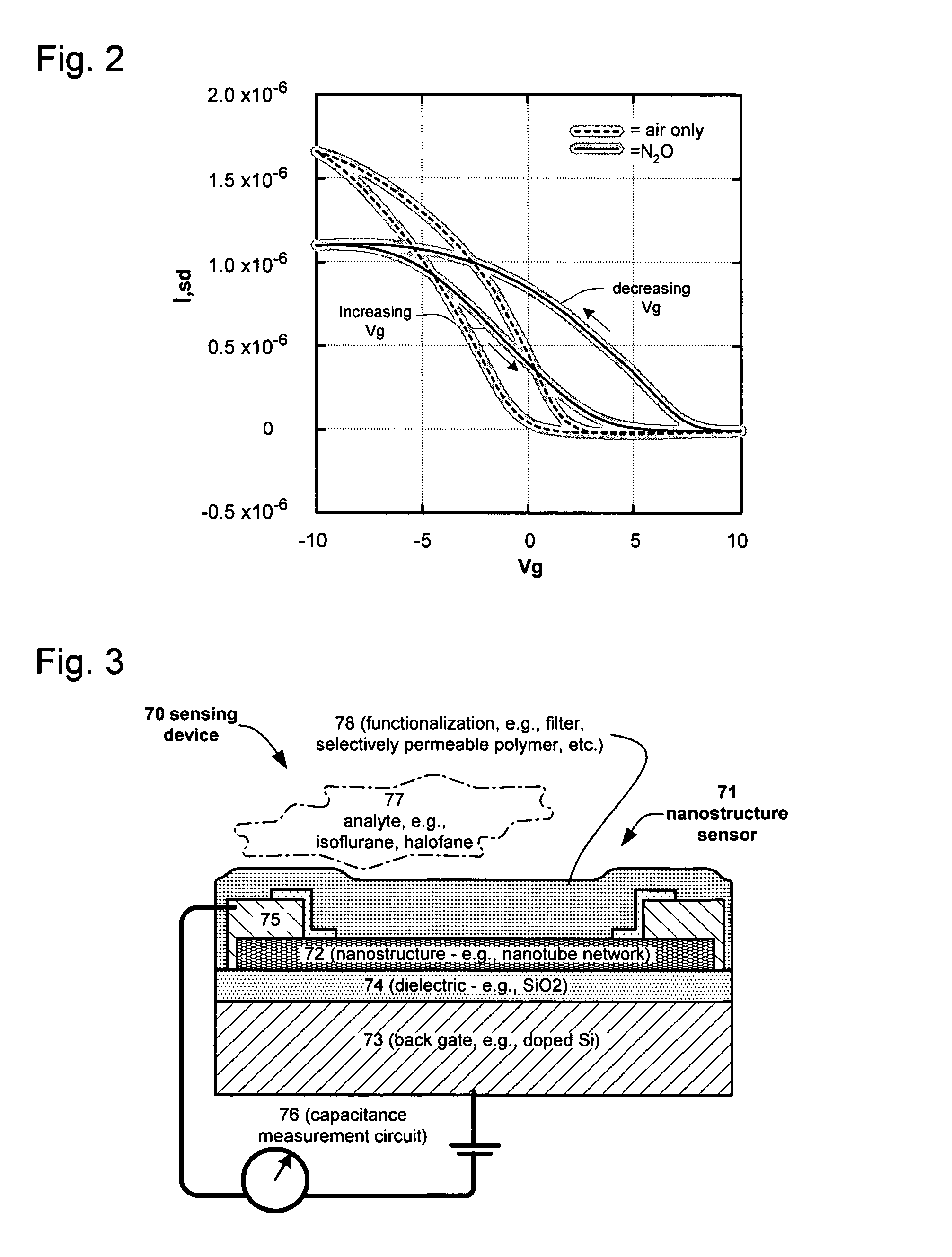Nano-electronic sensors for chemical and biological analytes, including capacitance and bio-membrane devices
a technology of capacitance and biomembrane, applied in nanoinformatics, instruments, material analysis, etc., can solve the problems of affecting the physical properties of carbon nanotubes, unable to demonstrate convincingly that useful detection of specific proteins or other large biomolecules can be accomplished in this way, and limiting the current technology in many ways. , to achieve the effect of enhancing the signal of detection
- Summary
- Abstract
- Description
- Claims
- Application Information
AI Technical Summary
Benefits of technology
Problems solved by technology
Method used
Image
Examples
embodiment 10
[0162]FIG. 12 is a plan view, cross-sectional view, and equivalent circuit diagram of an exemplary capacitive nanosensor embodiment 10 having aspects of the invention, comprising a bi-layer architecture including a substrate 11 (e.g., PET) and a conductive base or plate 12 (e.g., metal such as Au, graphite, and the like). A dielectric layer 13 (e.g., a polymer, SiO2, and the like, or combinations thereof) is interposed between base plate 12 and a nanostructured element 14 (such as one or more CNT or a CNT network). Nanostructured element 14 is capacitively coupled to conductive base 12 in that base 12 is space apart from element 14 to form a pair of capacitive plates. Digitated top lead 15 is shown contacting CNT element 14 to permit electrical communication with measurement circuitry (not shown). Preferably, top leads 15 are applied in such a manner as to prevent contact with base plate 12, so as to avoid a current path between a capacitive plate pair 12, 14, as shown in equivalent...
embodiment 20
[0163]FIG. 13 is a plan view, cross-sectional view, and equivalent circuit diagram of an alternative exemplary capacitive nanosensor embodiment 20 having aspects of the invention, comprising off-set capacitor elements in series, including a substrate 21 (e.g., PET) and an offset pair of conductive leads 22, 23 (e.g., metal such as Au, graphite, and the like), preferably disposed side-by-side adjacent substrate 21, separated by a selected gap. Dielectric layer 24 (e.g., a polymer, SiO2, and the like, or combinations thereof) covers active regions of leads 22, 23 and in turn supports CNT element 25, such as a carbon nanotube network. Advantageously, CNT element 25 forms a common capacitive plate electrode opposing both leads 22 and 23 (capacitively coupled), as shown in equivalent circuit 26.
embodiment 30
[0164]FIG. 14 is a schematic and equivalent circuit diagram which illustrates an exemplary capacitive nanosensor embodiment 30 having aspects of the invention, and having a bi-layered architecture comprising a first base lead or contact pad 32 disposed adjacent a substrate 31 (porous in this example, such as porous alumina). Lead 32 contacts a lower CNT plate or element 33, which is preferably shaped so as to have an active region 37 off-set from contact 32. At least the active region of plate 33 is covered by dielectric layer 34 (e.g., porous polymer or inorganic material such as SiO2). Upper CNT plate 35 covers at least the active region of lower plate 33, electrically isolated by dielectric 34, and is in turn contacted by a top lead or contact 36, which is likewise preferably offset from the active region 37. Thus, in FIG. 19, upper plate 35 is adjacent lower plate 33 and in electrical contact with lead 36, which is in turn offset and removed from proximity to plate 33. Analyte m...
PUM
 Login to View More
Login to View More Abstract
Description
Claims
Application Information
 Login to View More
Login to View More - R&D
- Intellectual Property
- Life Sciences
- Materials
- Tech Scout
- Unparalleled Data Quality
- Higher Quality Content
- 60% Fewer Hallucinations
Browse by: Latest US Patents, China's latest patents, Technical Efficacy Thesaurus, Application Domain, Technology Topic, Popular Technical Reports.
© 2025 PatSnap. All rights reserved.Legal|Privacy policy|Modern Slavery Act Transparency Statement|Sitemap|About US| Contact US: help@patsnap.com



